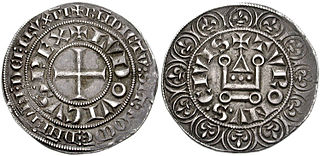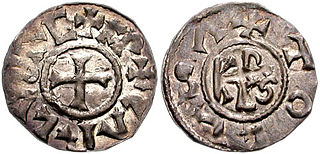The slash is the oblique slanting line punctuation mark /. Also known as a stroke, a solidus, a forward slash or several other historical or technical names including oblique and virgule. Once used to mark periods and commas, the slash is now used to represent division and fractions, exclusive 'or' and inclusive 'or', and as a date separator.

The shilling is a historical coin, and the name of a unit of modern currencies formerly used in the United Kingdom, Australia, New Zealand, other British Commonwealth countries and Ireland, where they were generally equivalent to 12 pence or one-twentieth of a pound before being phased out during the 1960s and 1970s.
The division sign is a symbol consisting of a short horizontal line with a dot above and another dot below, used in Anglophone countries to indicate mathematical division. However, this usage, though widespread in some countries, is not universal; it is used for other purposes in other countries and its use to denote division is not recommended in the ISO 80000-2 standard for mathematical notation.
Byzantine currency, money used in the Eastern Roman Empire after the fall of the West, consisted of mainly two types of coins: the gold solidus and a variety of clearly valued bronze coins. By the end of the empire the currency was issued only in silver stavrata and minor copper coins with no gold issue.

The solidus or nomisma was a highly pure gold coin issued in the Late Roman Empire and Byzantine Empire. The early 4th century saw the solidus introduced in mintage as a successor to the aureus, which was permanently replaced thereafter by the new coin, whose weight of about 4.5 grams remained relatively constant for seven centuries. In the Byzantine Empire, the solidus or nomisma remained a highly pure gold coin until the 11th century, when several Byzantine emperors began to strike the coin with less and less gold. The nomisma was finally abolished by Alexius I in 1092, who replaced it with the hyperpyron, which also came to be known as a "bezant". The Byzantine solidus also inspired the originally slightly less pure dinar issued by the Muslim Caliphate. In Western Europe, the solidus was the main gold coin of commerce from late Roman times to Pepin the Short's currency reform, which introduced the silver-based pound/shilling/penny system.

The aureus was a gold coin of ancient Rome originally valued at 25 pure silver denarii. The aureus was regularly issued from the 1st century BC to the beginning of the 4th century AD, when it was replaced by the solidus. The aureus was about the same size as the denarius, but heavier due to the higher density of gold.

The siliqua is the modern name given to small, thin, Roman silver coins produced in the 4th century A.D. and later. When the coins were in circulation, the Latin word siliqua was a unit, perhaps of weight defined by one late Roman writer as one twenty-fourth of a Roman solidus.
"Siliqua vicesima quarta pars solidi est, ab arbore, cuius semen est, vocabulum tenens."
A siliqua is one-twentyfourth of a solidus [coin], having its name from the tree of which it is the seed.

Metal Gear Solid 2: Sons of Liberty is a 2001 action-adventure stealth video game developed by Konami Computer Entertainment Japan and published by Konami for the PlayStation 2. Originally released on November 13, 2001, it is the fourth Metal Gear game produced by Hideo Kojima, the seventh overall game in the series and is a sequel to Metal Gear Solid (1998). An expanded edition, titled Metal Gear Solid 2: Substance, was released the following year for Xbox and Windows in addition to the PlayStation 2. A remastered version of the game, Metal Gear Solid 2: Sons of Liberty - HD Edition, was later included in the Metal Gear Solid HD Collection for the PlayStation 3, PlayStation Vita, and Xbox 360. The HD Edition of the game will be included on the Metal Gear Solid Master Collection Vol. 1 compilation for PlayStation 5, Xbox Series X/S and Windows in 2023.

Raiden, real name Jack, is a fictional character and one of the protagonists of Konami's Metal Gear series of action-adventure stealth video games. Created by Hideo Kojima and designed by Yoji Shinkawa, Raiden was introduced in the series as the main player character of the 2001 game Metal Gear Solid 2: Sons of Liberty. In Metal Gear Solid 2, he appears to be a member of the U.S. special operations unit FOXHOUND and is participating in his first mission against terrorists. Despite coming across as a young rookie, he is later revealed to have been a child soldier in his native Liberia. Raiden also appears as a supporting character in the 2008 game Metal Gear Solid 4: Guns of the Patriots, in which he is assisting the series' main protagonist Solid Snake in his fight against Revolver Ocelot's forces. He is also the main character of the 2013 game Metal Gear Rising: Revengeance, in which he is dealing with his past and his present life as a combatant who faces enemies from private military companies.
Liquid Snake is a fictional character from the Metal Gear franchise. He is the twin brother of series protagonist Solid Snake and the second product of Les Enfants Terribles, a top-secret government project to artificially create soldiers by cloning the legendary soldier Big Boss. He first appears as the central antagonist in the original Metal Gear Solid, where he leads the rogue FOXHOUND unit in a hostile takeover of a nuclear disposal facility in Alaska. The character returns in Metal Gear Solid V: The Phantom Pain as a child mercenary nicknamed the White Mamba with his real name revealed to be Eli.

Revolver "Shalashaska" Ocelot is a recurring fictional character in Konami's Metal Gear video game series. Throughout the series, he takes on a variety of roles: a major nemesis of Solid Snake, a friendly rival to Naked Snake, the right-hand man to Liquid Snake and Solidus Snake, and a close ally to Venom Snake. Ocelot has been well received by video game publications for his role as a central villain in the franchise, and has often been considered one of its most important characters for his connections with various characters.
In chemistry, materials science, and physics, the solidus is the locus of temperatures below which a given substance is completely solid (crystallized). The solidus temperature, TS or Tsol, specifies the temperature below which a material is completely solid, and the minimum temperature at which a melt can co-exist with crystals in thermodynamic equilibrium. The solidus is applied, among other materials, to metal alloys, ceramics, and natural rocks and minerals.

The tremissis or tremis was a small solid gold coin of Late Antiquity. Its name, meaning "a third of a unit", formed by analogy with semissis, indicated its value relative to the solidus. It was introduced into Roman currency in the 380s by the Emperor Theodosius I and initially weighed 8 siliquae.

The liquidus temperature, TL or Tliq, specifies the temperature above which a material is completely liquid, and the maximum temperature at which crystals can co-exist with the melt in thermodynamic equilibrium. It is mostly used for impure substances (mixtures) such as glasses, alloys and rocks.

The sol, later called a sou, is the name of a number of different coins, for accounting or payment, dating from Antiquity to today. The name is derived from the late-Roman and Byzantine solidus. Its longevity of use anchored it in many expressions of the French language.
Punctuation in the English language helps the reader to understand a sentence through visual means other than just the letters of the alphabet. English punctuation has always had two complementary aspects: on the one hand, phonological punctuation linked to how the sentence can be read aloud, particularly to pausing; and on the other hand, grammatical punctuation linked to the structure of the sentence. In popular discussion of language, incorrect punctuation is often seen as an indication of lack of education and of a decline of standards.
An obelus is a term in codicology and latterly in typography that refers to a historical annotation mark which has resolved to three modern meanings:

The Carolingian monetary system, also called the Carolingian coinage system or just the Carolingian system, was a currency structure introduced by Charlemagne in the late 8th century as part of a major reform, the effects of which subsequently dominated much of Europe, including Britain, for centuries. It is characterised by having three denominations in the ratio 1:20:240, the units of which went under different names in the different languages, but which corresponded to the Latin terms libra (pound), solidus (shilling) and denarius (penny).










